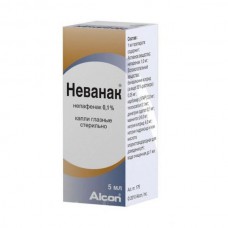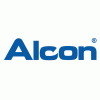Expiration date: 07/2026
Packaging
In dropper bottle to 5 ml of the drug. In the package 1 dropper bottle
Pharmacological action
Nepafenac the precursor of the active form of nonsteroidal anti-inflammatory drugs with anti-inflammatory and analgesic effect. The local application of nepafenac penetrates through the cornea of the eye, where with the help of hydrolases is becoming amfenac, the active form. Amfenac inhibits the action of cyclooxygenase (prostaglandin-H-synthase), the enzyme needed for production of prostaglandins.
The local application of nepafenac reduces swelling of the eye tissue and pain has no significant effect on intraocular pressure.
Pharmacokinetics
Suction
Nevanac rapidly absorbed through the cornea of the eye. With three times daily instillation of the drug Nevanac in both eyes in the blood plasma revealed a low measured concentration of nepafenac and amfenac after 2 and 3 h, respectively. Nepafenac the Cmax in plasma after topical application is 0.310±0.104 ng/ml, Cmax of amfenac - 0.422 ±0.121 ng/ml.
Cmax of nepafenac average in watery moisture is observed after 1 h.
Distribution
Amfenac has a high affinity to serum albumin. In vitro binding to rat albumin, human albumin and human serum was 98.4%, 95.4% and 99.1%, respectively.
Studies in rats have shown that radioactively labeled substances related to the active substance, widely distributed in the body following single and multiple application of oral doses of 14C-nepafenac.
Metabolism
The local application under the action of intraocular hydrolases nepafenac undergoes rapid hydrolysis to amfenac.
Further metabolism of amfenac proceeds through hydroxylation of the aromatic ring, leading to the formation of conjugates with glucuronic acid. Radiochromatographic analysis conducted before and after hydrolysis involving P-glucuronidase showed that all the metabolites were represented in the form of conjugates with glucuronic acid, with the exception of amfenac. Amfenac was the main metabolite in plasma - the share of this substance accounted for about 13% of the total radioactivity detected in the plasma. The second occurrence in the plasma was the metabolite 5-hydroxynaphthoic from 9% of total radioactivity at Cmax.
Breeding
Nepafenac report mostly kidneys (about 85% of the radioactive label after oral administration of 14C-nepafenac found in the urine and about 6% in the faeces), however the concentration of nepafenac and amfenac in the urine can not be quantified.
Indications
Treatment and prevention of postoperative pain and inflammation in surgical operations for cataract.
Contraindications
- bronchial asthma, COPD, urticaria or acute rhinitis caused by acetylsalicylic acid or other nonsteroidal anti-inflammatory drugs,
- children under 18 years,
- hypersensitivity of an organism,
- pregnancy, lactation.
Application of pregnancy and breastfeeding
Not recommended during pregnancy and lactation. If necessary, the appointment during lactation breastfeeding should stop at the time of treatment.
Tests on animals showed reproductive toxicity. In the study of the impact of nepafenac on the reproductive organs of rats receiving toxic doses > 10 mg/kg resulted in dystocia, increase in the number of miscarriages at the stage after implantation, reduced body mass and growth of embryos, reduced survival of embryos. In pregnant rabbits receiving low doses of 30 mg/kg resulted in an increase in malformations of the offspring.
Special instruction
Patients should avoid exposure to sunlight.
The use of NSAIDs for topical application may lead to the development of keratitis. In some susceptible patients, prolonged use of nonsteroidal anti-inflammatory drugs for topical application can cause the rupture of epithelial cells, corneal thinning, corneal erosion, ulceration on the cornea or perforation of the cornea. These side effects can create the risk of vision loss. Patients with signs of rupture of the epithelial cells of the cornea, should immediately stop the drug and be monitored, the purpose of which is to monitor the state of the cornea.
The use of NSAIDs for topical application can slow down or delay the healing process. It is also known that the corticosteroids for local application slow or delay healing. The simultaneous use of NSAIDs for topical application and corticosteroids for local application can slow down or delay the healing process.
Experience with the use of NSAIDs for topical application implies that patients with complications after surgical ophthalmic interventions, denervation of the cornea, defects of the corneal epithelium, diabetes, superficial diseases of the eye (e.g. dry eye syndrome), rheumatoid arthritis, or repeated surgical interventions carried out within a short period of time, may have an increased risk of developing adverse reactions from the side of the cornea, which can create the risk of vision loss. NSAIDs for topical application should be used with caution when treating these patients. Prolonged use may increase the risk of occurrence and severity of adverse reactions in the cornea.
The use of NSAIDs for topical application in combination with surgery on the eye can cause internal bleeding in the tissues of the eye (including giveme). Nevanac the drug should be used with caution in patients with a history of documented tendency to bleed, or if patients receive other drugs that may increase blood coagulation time.
Data on the simultaneous use of prostaglandin analogues and drug Nevanac do not exist. Given the mechanisms of their action, concurrent use is not recommended.
The preparation contains the preservative benzalkonium chloride which may cause eye irritation and discoloration of soft contact lenses. In addition, wearing contact lenses is not recommended during the postoperative period after surgery for cataract. It is not recommended to use contact lenses during treatment Nevanac.
Studies have shown that benzalkonium chloride, which is contained in the drug Nevanac can cause pitting keratitis and/or toxic ulcerative keratitis. Therefore, when frequent or prolonged use of the drug requires careful medical monitoring of patients.
The use of NSAIDs for topical application may prevent the timely detection of symptoms of acute eye infections, because they do not possess any antimicrobial properties. In the case of eye infection, use of nonsteroidal anti-inflammatory drugs for local use simultaneously with antibacterial agents should take precautions.
Cross sensitivity
The application of nepafenac there is the possibility of developing cross-sensitivity to acetylsalicylic acid, a derivative phenyloxazol acid and other NSAIDs.
Do not touch the tip of dropper bottle to any surface to avoid contamination of the vial and its contents.
The bottle must be closed after each use.
Effects on ability to drive vehicles and management mechanisms
After application of the drug may be a temporary reduction in clarity of visual perception, and to restore it is not recommended to drive and engage in activities requiring increased attention and reaction.
Composition
1 ml contains:
Active substance: nepafenac 1 mg
Auxiliary substances: benzalkonium chloride (50 % solution) 0.05 mg, carbomer 974? 5.0 mg, tyloxapol 0.1 mg, disodium edetate 0.1 mg mannitol 24.0 mg, sodium chloride 4.0 mg, sodium hydroxide and/or hydrochloric acid to bring the pH, purified water to 1 ml.
Method of application and doses
Locally. Before use, shake.
1 drop into the conjunctival SAC of the eye (eye) 3 times a day. The treatment begins 1 day before surgery about cataract surgery and continued for the first 2 weeks of the postoperative period (including day of surgery). Over 30-120 minutes before surgery, you should get an additional drop of the drug.
Side effect
Local: in 1-10% of cases, there is a point keratitis, pain and itching in the eye, blurred vision, dryness of the conjunctiva, foreign body sensation, crusting on the eyelids. 0.1-1% of cases iritis, keratitis, corneal deposits, choroidal effusion, discharge from eyes, photophobia, eye irritation, allergic conjunctivitis, disorders of the eyelids, discomfort in the eyes, increased lacrimation, conjunctival hyperemia.
Systemic side effects in 1-10% of cases, headache. In 1-4% of cases - increased blood pressure, nausea, vomiting, sinusitis. 0.1-1% of cases - dry mouth, skin extensibility (dermatochalasis), increased chustvitelnost sensitivity.
Post-marketing surveillance (frequency not known): ulcerative keratitis, defect/disease of the corneal epithelium, corneal damage, formation of an inflammatory infiltrate in the anterior chamber, the deterioration of the healing process of the cornea, decreased visual acuity, corneal scar, corneal opacity.
Patients with signs of cornea damage should immediately stop the drug and to thoroughly examine the condition of the cornea. Experience with the use of nonsteroidal anti-inflammatory drugs for local use suggests that patients with ophthalmic complications after surgical interventions, denervation of the cornea, defects of the corneal epithelium, diabetes, superficial diseases of the eye (e.g. dry eye syndrome), rheumatoid arthritis, or repeated surgical interventions carried out within a short period of time, may have an increased risk of developing adverse reactions from the side of the cornea, which can create the risk of vision loss.
Drug interaction
In studies in vitro, no, nepafenac nor amfenac not inhibit the metabolic activity of human cytochrome P450 (isoenzyme CYP1A2, 2C9, 2C19, 2D6, 2E1 and ZA4) at concentrations up to 300 ng/ml. Therefore, if concomitant use with other drugs interactions involving cytochrome P450 isoenzymes is unlikely. It is also unlikely interactions mediated by plasma protein binding.
Data on the simultaneous use of the drug Nevanac and of prostaglandin analogues do not exist. Given the mechanisms of their action, concurrent use is not recommended.
If necessary, can be used in combination with other ophthalmic drugs for topical application. In this case, the interval between their use shall be not less than 5 minutes.
Overdose
Data on overdose of the drug available. In case of contact with eyes, excessive amount of the drug is recommended to wash the eyes with warm water.
Storage conditions
Store the drug at temperatures from 2° to 30°C and out of reach of children.
Shelf life
2 years. After opening bottle, use within 4 weeks.


